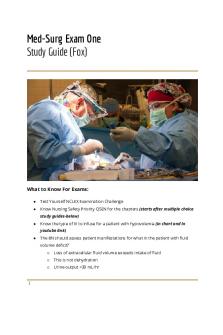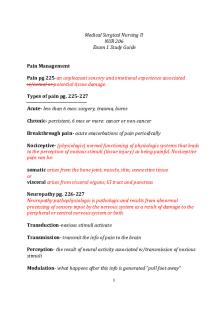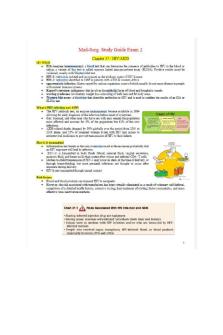MED SURG 1 Final EXAM Study Guide PDF

| Title | MED SURG 1 Final EXAM Study Guide |
|---|---|
| Course | Primary Concepts Of Adult Nursing |
| Institution | Nova Southeastern University |
| Pages | 10 |
| File Size | 309.8 KB |
| File Type | |
| Total Downloads | 30 |
| Total Views | 136 |
Summary
summary is based on the information provided by the Medical Surgical Nursing textbook...
Description
SUSSET H. ALCOVER ! ! MED SURG 1 FINAL EXAM STUDY GUIDE ~JUST IMPORTANT KEY POINTS TO KNOW~ •
•
•
•
•
•
•
•
!
Chronic Disorders § > 3 months § Assist with copying, and importance about compliance of Tx. and lifestyles changes. Delegation § DO NOT delegate to the LPN: assessment, teaching or evaluation § DO NOT delegate to the UAP: task requiring nursing judgement, medication administration, assessing, teaching, or evaluation Prioritization – ABC, RACE Hematological Disorders Anemias § S/S: low RBC and H/H, pallor (assess mucous membranes), fatigue (safety, risk for injury), hypoxia, decreased BP, increased PR (monitor VS) Iron Deficiency Anemia § Microcytic, hypochromic § Results from decreased dietary intake of iron in the diet – food sources high in iron: organ meats (beef, liver), beans, leafy green vegetables, raisins and molasses § Most common causes: bleeding from ulcers, gastritis, IBD; menorrhagia in premenopausal women, and inadequate iron supplement in pregnancy § Smooth sore (inflamed) tongue, brittle nails and angular cheilosis § Iron Supplements o Tell the pt. taking iron supplements that is normal for the stool to be dark color, but not black tarry o Side effects: constipation, N/V o Important to take with vitamin C (orange juice) to enhance absorption, but not with milk or antacids (decrease absorption) o Take an hour before meals, because it is best absorbed in an empty stomach o Iron supplements (liquid preparations) – mix it, use a straw, stain teeth Vitamin B12 § Megaloblastic Anemia – RBCs abnormally large § Least common cause: inadequate dietary intake – occurs in strict vegetarian – Increase oral supplements with vitamin or fortified soy milk § Most common cause: Absence of intrinsic factor after bariatric surgery or gastrectomy à Pernicious Anemia § Smooth, sore, red tongue – include assessment of the tongue, confused, paresthesia, loss of proprioception (unsteady gait) – risk for injury, careful neurologic assessment, lastly jaundice is present § Vitamin B12 injections – monthly, IM, lifelong Sickle Cell Anemia § Inheritance of the hemoglobin (HbS) gene § Higher incidence in African Americans § Complications: Thrombosis, Hypoxia, Infection § Pain, Hydration, Oxygen § Careful assessment of all body systems D/T vaso-occlusive crisis à interrupt blood flow, thrombo formation, hypoxia, ischemia Thrombocytopenia § Low Platelet count – Risk for bleeding § < 20,000 mm3 – excessive bleeding – Petechiae occurs § Assess nasal and gingival gums for bleeding § Promote Safety – Fall Prevention
1
SUSSET H. ALCOVER ! ! •
•
Blood Transfusions § Pre-procedure o Check there’s an order for transfusion o Check the pt. has been typed and cross-matched o Verify that pt. has signed a written consent form. o Explain procedure to pt. Instruct pt. in S/S of transfusion reactions (itching, hives, swelling, SOB, fever, chills) o Take VS to stablish a baseline o Hand hygiene. Gloves. o Use a 20 gauge or larger needle for insertion in a large vein (18 is preferable) § Procedure o Make sure the transfusion is initiate within 30 minutes after removal of the packed RBCs from the blood bank refrigerator. o For the first 15 min., run the transfusion slowly, no faster than 5 mL/min. Observe pt. carefully for adverse effects. If not adverse effects occur during the first 15 min., increase rate unless pt. is at high risk for circulatory overload. o Monitor closely for 15-30 min for S/S of reaction. If any occur, STOP transfusion, NOTIFY PCP. o Note that transfusion administration time does not exceed 4 hrs., because of increased risk for bacterial proliferation § Postprocedure o Obtain VS. Compare with baseline measurements. o Dispose materials properly à biohazard bag o Document o Monitor pt. For response and effectiveness of procedure. Platelet Transfusion – same thing just infuses over 30-60 min to diminish clumping over administration Oncological Disorders Leukemia
•
AML § Low RBC – anemia – fatigue – Risk for Injury § Low Platelets – Thrombocytopenia – bleeding, bruises and Petechiae § Low neutrophils – Neutropenia – Hand hygiene, sign in the door (neutropenic precautions), proper PPEs, no flowers, or fruits or vegetables, fever and infection is present, restriction of visitors § Bleeding and infection are the most common cause of death § Chemotherapy Tx. o Chemo destroy the cells leaving behind the by product and waste such as uric acid, K, P – Increased renal stone formation which can cause renal failure. Hyperkalemia and hypocalcemia can lead to cardiac
!
2
SUSSET H. ALCOVER ! ! dysrhythmias; hypotension; neuromuscular effects such as muscle cramps, weakness, and spasm/tetany; confusion; and seizures. Anorexia, nausea, vomiting, diarrhea, and severe mucositis are common. •
•
•
•
•
!
CML § Increase incidence in pts. with Philadelphia chromosome (chromosome 22) § Chronic – asymptomatic ALL § L – Lymphoid – B cells and T cell specifically affected but because lymphoblast infiltrates de bone marrow it also affects myeloblast process (RBC – anemia, WBC – infection, Platelets - bleeding) § A Little Little boy – more common in children, young people and more common in boys than girls § Very responsive to Tx. § CNS involvement § Chemo Tx. – consequences of chemo § Corticosteroids based chemotherapy – more susceptible to infections § NI: same as AML CLL § More common in older adults § Chronic - asymptomatic § Family Hx. – most important risk factor § Exposure to pesticides or chemical exposure – veterans of Vietnam war who were exposed to agent orange § Malignancies of B cell antibodies, scape apoptosis, accumulate in the bone marrow and circulation § Complications: hemolytic anemia or ITP, and a greater risk for developing other cancers § Increased lymphocyte count is always present § Decreased RBC and platelets may be present in some stages § Lymphadenopathy is common, sometimes painful § Fever, night sweats, unintentional weight loss § Increased risk for developing infections with encapsulated organisms such as the flu HL - Hodgkin Lymphoma § High cure rate § more common in men, 20s - > 50s § Most commonly seen in patients receiving chronic immunosuppressive therapy (ex: HIV, IgA, IgG) and also veterans of the military who were exposed to the herbicide agent orange. § Initiates in a single node – and usually begins as an enlargement on one or more lymph nodes on one side of the neck § Lymph nodes are painless and firm but not hard § Spreads by continuous extension along the lymphatic system § Reed-Stenberg cell § Unknown cause § All organs are vulnerable to invasion by tumor cells. The symptoms result from compression of organs by the tumor, such as cough and pulmonary effusion (from pulmonary infiltrates), jaundice (from hepatic involvement or bile duct obstruction), abdominal pain (from splenomegaly or retroperitoneal adenopathy), or bone pain (from skeletal involvement). Herpes zoster infections are common. § Fever (without chills), night sweats, and unintentional weight loss. § Assessment of lymph nodes and lymph nodes biopsy, bone marrow biopsy, CBC, platelet count, ESR, liver and renal function studies, spleen and liver assessment § Tx. goal – cure – chemotherapy § Long term follow up because complications may develop years after Tx. § Nurse should encourage to reduce other factors that may lead to development of second cancers: tobacco, alcohol, sun exposure NHL – Non-Hodgkin Lymphoma § The median age at diagnosis is 65 years and the incidence has increased in people with immunodeficiency or autoimmune disorders § Involves malignancies of B lymphocytes
3
SUSSET H. ALCOVER ! ! § § § § § § § •
•
•
Lymphadenopathy fever, night sweats, unintentional weight loss, ABD discomfort, nausea and anorexia Tx. depend on stage of the disease: non-aggressive, localize – radiation; aggressive – chemotherapy survival is very low CNS involvement in more aggressive stages Very high risk for infection Good assessment of the lymph nodes
Myeloma § Too much abnormal plasma cells (antibodies) – destroy bone § Production of abnormal antibodies (M protein) found in the blood and urine § CRAB: hypercalcemia, renal failure, anemia, bone lesions (fractures) and pain § Bone marrow biopsy to confirm Dx. § No cure § Develops slowly § Pain management § Avoid NSAIDs § Assess renal function § No heavy lifting § Increase fluids to excrete excess calcium § Tx: chemo and corticosteroids – Nursing Interventions R/T these two Polycythemia § red lady – ruddy complexion (red) § too much RBCs § splenomegaly § > 65 Y.O, most common in males § Death typically occurs from thrombosis, hemorrhage. It can progress to AML § High risk for DVTs – AVOID sedentary behavior, crossing of the legs, wearing tight and restrictive clothing § blood viscosity – angina, claudication, dyspnea, stroke, thrombophlebitis, elevated BP § Avoid risk factors that precipitate thrombosis – smoking, obesity, alcohol, HTN, diabetes § Assess for bleedings – nosebleeds, ulcers, frank GI bleeding, hematuria, intracranial hemorrhage § Avoid iron supplements Neutropenia § High risk for infection § Managing infections is the most important intervention § Hand hygiene, sign in the door (neutropenic precautions), proper PPEs, no flowers, or fruits or vegetables, fever and infection is present, restriction of visitors
*** Radiation Therapy – Nurse should provide care spending as little time as possible in the room, no pregnant nurses allowed to care for a pt. after radiation therapy, if a vaginal or rectal implant of a pt. receiving radiation falls > leave it in place call Radiology. Educate the pt. after radiation or being discharge after radiation to not sleep close to somebody else, get close to children or pregnant women.
•
!
Immune Disorders HIV/AIDS § Education: proper protection during sex, correct use of condom, “abstinence is the best protection to avoid HIV” § Risk: infected needles – drug abusers, HCP, sexual relationships with infected people, mother to child during childbirth, breastfeeding. § Loss, of appetite, N/V, chronic diarrhea – profound weight loss, F/E imbalances – Skin integrity, activity intolerance, weight, BUN, albumin § Candidiasis – Assess oral cavity for redness, ulceration and white creamy patches – Dysphagia § Kaposi Sarcoma – Skin integrity, susceptible to infection – regular turning Q.2.H, meticulous skin care, analgesic for pain, wound care, risk for social isolation
4
SUSSET H. ALCOVER ! ! § §
•
•
D/T chronic diarrhea – assess the skin and provide care P. Pneumonia (AIDS) – non-productive cough, fever, chills, SOB, dyspnea – Respiratory failure can develop – Monitor O2Sat, breast sounds, VS – Assist pt. in semi or high fowler position, increase fluid intake to decrease viscosity, adm. O2, energy conservation § HIV encelopathy (AIDS dementia) – risk for injury, altered thought process, disturbed sensation, self-care deficits § Standard Precautions is used with all patients § Pt. with HVI at risk for infection – Isolation precaution § Hand hygiene, use of PPEs, handle soiled pt.’s equipment appropriately, do not recap needles and place in the sharp container. Allergic Disorders § Anaphylaxis – Breathing compromised § The pt. should be instructed to avoid substances that he or she is allergic to, and to carry and Epi-Pen SLE § Autoimmune inflammatory, women, African Americans § Fever, malaise, weight loss, anorexia § Butterfly rash – risk for social isolation § Oral ulcers § Arthritis, joint swelling, tenderness and pain accompanied by morning stiffness § Pericarditis § Nephritis – assess creatinine, routine urinalysis to avoid HTN and kidney failure § + ANA § CBC – anemia, thrombocytopenia, leukopenia § Tx. corticosteroids, immunosuppressive – increased risk for infection § Educate - AVOID sun exposure, protect with sunscreen and clothing, to prevent exacerbation of the disease Upper GI Disorders
•
•
•
!
Hiatal Hernia § Heartburn, regurgitation and dysphagia § Pt. Usually feels a sense of fullness or chest pain after eating § Frequent small feeding, not to recline for 1hr after eating § Elevate the HOB GERD § Pyrosis (heartburn), dyspepsia, regurgitation, hypersalivation § S/S mimics those of heart attack – so good assessment is necessary § Can lead to Barret’s esophagus – cancer § Eat low fat diet, avoid caffeine, tobacco, milk, beer, foods containing peppermint, spearmint, and carbonated beverages § Avoid eating or drinking two hours before BT § Maintain normal body weight § Avoid tight fitting clothes § Elevate HOB, or put pillows under PUD § Increase with age § Stress, H. Pylori (transmittable through water and food, and fecal), excessive use of NSAIDs and excessive secretion of HCl § Burning sensation in the mid-epigastrium or back § Gastric ulcers: pain occurs immediately after eating, 30-60 min § Duodenal ulcers: pain occurs 2-3 hrs. after eating, pain relieved by eating or antacids, pain awakes the pt. during the night § Check stools for blood, CBC § Antibiotics for H. Pylori – teaching about antibiotic: follow the entire course of antibiotic Tx. as prescribed § Manage gastric acidity: meds, stop smoking, manage stress, avoid extreme temperature in food and beverages, eat three regular meals to neutralize acidity
5
SUSSET H. ALCOVER ! ! *** When a pt. presents with S/S such as N/V and ABD pain – laxatives or cathartic are contraindicated because it can lead to perforation, peritonitis. Lower GI Disorders Appendicitis § RLQ, sharp, well localized pain – if vague, diffused pain may indicate peritonitis § Elevated WBC, fever, N/V, loss of appetite § Mc Burney’s point, Rebound Tenderness Test § Do pregnancy test to rule out ectopic pregnancy, and urinalysis to rule out UTI § Uncommon in older adult, DO EKG and chest x-ray to rule out MI and pneumonia § Major complications: perforation > peritonitis and abscess formation § Tx. – Immediate Sx. § If perforation occurs – antibiotics, and Jackson Pratt and then after abscess is drained appendectomy § Prepare for Sx. – IV fluids, antibiotic therapy, if paralytic ileus – NGT § Post-op. –High fowlers to reduce tension in the ABD, pain meds, oral fluids when tolerated, foods is provided when normal bowel sounds return, pt. education – how to care for the incision after discharge • Peritonitis § Sepsis is the major complication, shock may result from septicemia § IV fluids § Pain meds § O2 § Sx. § Wound care after Sx. • Crohn’s Disease § Young people, smokers § Transmural; distal ileum, ascending colon, ulcers are separated from each other “cobblestone appearance” § Fistulas, fissure and abscesses § RLQ pain – can confuse with appendicitis § Crampy pain after meals – pt. Tends to avoid eating – anemia - check albumin levels, weight § Diarrhea § Steatorrhea § Melena § Low H/H, albumin, elevated WBC, ESR § Increased risk for colon cancer • Ulcerative Colitis § Mucosal and submucosal § Rectum and colon § Systemic complications and high mortality rate § Continuous lesions § Diarrhea, passage of mucous and pus § 10-20 liquid stools each day § LLQ pain § Rectal bleeding – stool positive for blood § Anemia – S/S: pallor, fatigue, HOTN, tachypnea § Low H/H, increased WBC, decreased albumin § Sx. – Ileostomy ***Management of IBD: oral fluids, low residue (low fiber), high protein, high caloric diet with supplemental vitamins and iron. Avoid foods that exacerbate diarrhea (milk), cold foods and smoking are avoided because increase intestinal motility. PTN – glucose problems, ACC. NPO – to provide bowel rest, post sign in the pt.’s room
•
!
6
SUSSET H. ALCOVER ! ! •
•
• •
•
•
•
!
Obstructions Small Bowel Obstructions § Crampy, wavelike colicky D/T persistent peristalsis § Pt. may pass blood and mucous but not fecal matter and not flatus § Fecal vomiting can occur § S/S of dehydration – assess for dehydration – mucous membranes, skin turgor § Vomiting – F/E imbalances § Hypovolemic shock § NGT to decompress the bowels Large Bowel Obstructions § Develop slowly, constipation may be the only sign for months § Blood loss in stool – anemia § ABD extremely distended § Fecal vomiting § Shock may occur § Colostomy GI Bleeds Upper GI Bleeds: black tarry stools – melena – Occult blood test is needed Lower GI Bleeds: visible blood in the stools Biliary and Pancreatic Disorders Gallbladder § Jaundice o Skin and mucous membrane yellow color o Pruritus (itching) o Urine – very dark amber color o Stool – grayish (like putty) or clay colored § Cholelithiasis o Epigastric pain following a meal rich in fatty content, fullness, ABD distention, vague pain in the RUQ Cholecystitis § RUQ pain, may radiate to the midsternal area or right shoulder § S/S of inflammation § calculous is the more common cause § Sx. removal of gallstones § Post op. care – Fowler’s, IV fluids § Respiratory care – ABD incision > prone to pulmonary complications – take deep breaths and cough q.1.h, incentive spirometry, early ambulation § Draining tube after Sx. – assess bile drainage, if not draining properly may indicate backflow of bile into the bloodstream – jaundice § Encourage diet low in fats and high in carbohydrates and proteins immediately after Sx. (of course, when bowel sounds return) Pancreatitis § Acute o Cholelithiasis and alcohol are the major causes o Pain frequently occurs 24-48 hrs. after a heavy meal or alcohol, diffuse and difficult to localized, and unrelieved by antacids o Severe ABD pain in the midepigastrium are, and tenderness and back pain o Ecchymosis (bruising) in the flank or around the umbilicus o Serum amylase and lipase are elevated within 24 hrs. of S/S, serum amylase returns to normal within 4872 hrs. and serum lipase stays elevated, urinary amylase stays elevated longer than serum amylase. o Elevated WBC o Transient hyperglycemia (insulin may be required), and glycosuria, and elevated serum bilirubin
7
SUSSET H. ALCOVER ! ! NPO to inhibit stimulation of the pancreatic enzymes, IV fluids to maintain electrolytes balance PTN – monitor glucose levels Pain management and comfort When oral feeding are reintroduced – diet high in proteins and low in fat, avoid heavy meals and alcohol NGT to reduce N/V and treat ABD distention Bed rest to reduce activation of pancreatic enzymes, and semi fowlers for respiratory system *** Rigid, boardlike ABD indicates peritonitis § Chronic o Recurrent episodes of acute pancreatitis o Alcohol is the major cause o So painful that large doses of opioids are not effective – Risk for opioid dependency o Malabsorption occurs late in the disease – digestion, specially proteins and fats are impaired. Stools becomes more frequent, frothy, foul smell, because impaired fat digestion > steatorrhea o o o o o o
•
•
• • • • • • • • • •
•
•
!
Diabetes Care of the patient with Type 1 § Insulin dependent § Watch for S/S of DKA – polyuria, polydipsia, polyphagia, hyperglycemia, ketones, metabolic acidosis, breath ha a fruity odor § “Sick day” Rule – do not miss insulin doses when sick, even if the pt. cannot eat § If S/S of hypoglycemia – give a form of simple carbohydrate such as orange juice, do not add extra sugar § If unconscious – insulin IV followed by a simple form of CHO, when pt. is awake § If Sx. hold the insulin dose – call the physician or surgeon to know what to do next Care of the patient with Type 2 § Insulin resistance § Diet and exercise helps with the disease § Oral medication is the first choice of Tx. § If other measures fail – insulin § If uncontrolled diabetes > HHS – Hyperglycemic, hyperosmolar (non-ketone) syndrome Increased risk for CVD CHO should be eaten in moderation, as well as fats Alcohol impair insulin absorption Daily blood gluco...
Similar Free PDFs
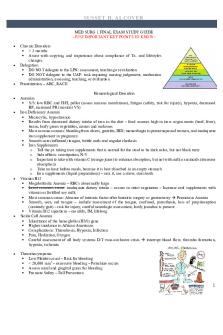
MED SURG 1 Final EXAM Study Guide
- 10 Pages

Med surg exam 1 study guide
- 25 Pages
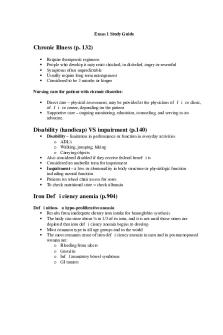
Exam 1 Study Guide - Med-Surg
- 26 Pages

Med Surg 2 Final Study Guide
- 25 Pages
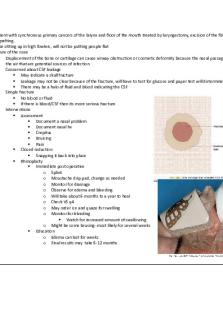
Med Surg II - Exam 2 Study Guide
- 57 Pages

Med Surg 2 Exam 3 Study Guide
- 22 Pages

Med surg exam 3 study guide
- 68 Pages

Med Surg Study guide Notes
- 66 Pages

Med Surg Final exam review
- 12 Pages

Med-Terms Final Exam Study Guide
- 34 Pages

Med Surg Exam 3
- 19 Pages
Popular Institutions
- Tinajero National High School - Annex
- Politeknik Caltex Riau
- Yokohama City University
- SGT University
- University of Al-Qadisiyah
- Divine Word College of Vigan
- Techniek College Rotterdam
- Universidade de Santiago
- Universiti Teknologi MARA Cawangan Johor Kampus Pasir Gudang
- Poltekkes Kemenkes Yogyakarta
- Baguio City National High School
- Colegio san marcos
- preparatoria uno
- Centro de Bachillerato Tecnológico Industrial y de Servicios No. 107
- Dalian Maritime University
- Quang Trung Secondary School
- Colegio Tecnológico en Informática
- Corporación Regional de Educación Superior
- Grupo CEDVA
- Dar Al Uloom University
- Centro de Estudios Preuniversitarios de la Universidad Nacional de Ingeniería
- 上智大学
- Aakash International School, Nuna Majara
- San Felipe Neri Catholic School
- Kang Chiao International School - New Taipei City
- Misamis Occidental National High School
- Institución Educativa Escuela Normal Juan Ladrilleros
- Kolehiyo ng Pantukan
- Batanes State College
- Instituto Continental
- Sekolah Menengah Kejuruan Kesehatan Kaltara (Tarakan)
- Colegio de La Inmaculada Concepcion - Cebu
